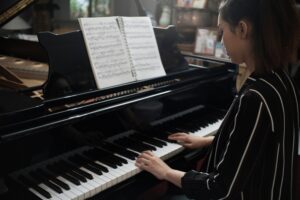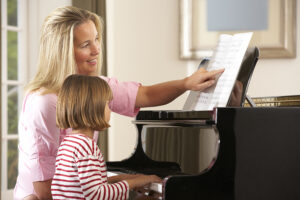This article is for teachers of young beginners on piano who need lesson plan ideas. General thoughts included here work especially well for the first 3 months of study, which is when a routine and familiarity is established with the instrument.

For young beginners, piano study is a great way to begin music lessons, and the piano can function as a gateway to other instruments. Some teachers, though, may find the 4, 5, and 6 year old age group a difficult one to approach, as the lessons must be conducted a bit differently to accommodate the fact that students are still learning to read, do not have fully refined fine motor skills, and need lessons to meet their attention span.
So say you are a piano teacher starting with a young beginner and want some ideas on how to make the lessons successful and meet the needs of this age group. Never fear! I have included some tips and advice on how to develop your lesson plans at a great pace and keep enthusiasm levels high—for both yourself and the student.
What books should piano teachers use?
In advising other teachers on what methods work best for 4, 5 and 6 year olds, my go-tos are the “My First Piano Adventure” books by Faber and the “Music for Little Mozarts” series by Alfred. Both methods are excellent resources, but I am partial to the Faber books as a necessary part of the curriculum, and I’d make sure to introduce the Lesson Book A and Writing Book A as a first step. If you would like to incorporate the Lesson Book of the Alfred series in conjunction with the Faber books as an added resource, I think that’s a great idea, as one or the other may resonate better with an individual student, and variety is always great for young beginners.
One of the reasons I really enjoy the Faber series is that games and interactive exercises in the first several lessons are included, and these can always be explored over and over. An example is the “Stone on the Mountain” interactive exercise that gets students ready to play by establishing a correct hand shape. Another is the improvised duet at the very beginning of the book—I actually warm up with this for the first 3 months of study with all young students.
Keep it Moving!
Let’s get into the mindset of a 5-year-old. It’s really tough to sit still, everything is new and exciting, and you want to bounce around from one new thing to another. As teachers, we have to understand that working in a concentrated way for even 10 minutes on the same song can get really boring. This is where the creativity of the teacher needs to come in. Don’t let the lesson get stale and uninteresting by not moving on to something else. In your lessons, try to focus on one component of a song or exercise as the goal for that week. For example, if a hand position is tough for a student to find or establish, make the lesson on that song just mastering the placement of the hands for that week. If the student needs a practice assignment based around this, it’s just to go to the piano, place hands correctly, and that’s it! Now the key to making this successful, though, is that there needs to be many songs and exercises that are used in one lesson…which brings me to my next point….
Repeat, Repeat, Repeat!
In piano lessons for an 8 or 9 year old, most often, a student masters an assignment, and you move on to the next. I strongly advise against this pace for a young beginner. I think having a collection of songs that are mastered and in progress to review each week makes the lessons much more fun for the student, because as they are learning new things, they are still able to play songs with which they are very comfortable. This contributes to positive self-esteem about their playing ability and makes the lessons more fun! An added bonus for the teacher is that accompaniment can be added, you can work on technique, and you can have a collection of favorites for them to share with their family. Feel free to take a slow pace with adding new songs, especially in the very beginning, and review the first 5 songs many times before moving on. After a few months, this process won’t be needed as much, and a normal flow with new songs can be incorporated.
Also, having songs that are familiar to play helps students develop fine motor skills through repetition, and they will be much more likely to practice a song they understand when sitting down at the instrument.
What about Parents Asking about Practice?
In all practicality, a 4, 5 and 6 year old in their first lessons will probably not sit down and practice their assignments on their own. Also, in the first few lessons with a young beginner, most of the lesson is focused on establishing basic bearings—like which direction is high or low, or what the pattern of black keys is on the instrument. When parents ask me how much a student this age should be practicing, my answer is “as much or as little as they want for the first month, and they shouldn’t be expected to play anything specific—I would love it if they just sit down at the piano and play something they make up.”
While this may seem like I’m not expecting practice at all, that’s really not the case. I always show parents the pages I worked on with the student at the end of the first several lessons or whenever they ask, so they can help in the first month of practice on the instrument. However, the most important thing for a young beginner is to get comfortable with simply sitting at the instrument and exploring the sound at the on-set of lessons. Even by making up a melody or playing random notes, a student starts to get a sense of what moving up is, or where the high notes are, etc. I’ve never had a parent question this answer. In fact, it’s somewhat of a relief to a lot of parents in that an expert is telling them that this is what is to be expected.
After those “familiar and repetitive” songs I discussed earlier are mastered, though, we now have something the student can play each week. Around the second month of study is when I start setting little goals to play a song a certain number of times, etc.
Beginners Piano – A great place to start!
There is so much to be said about piano lessons with 4, 5, and 6-year-olds on piano, and as a teacher, I really love this age group. I also really enjoy working with teachers to give advice about this age group, because such a huge opportunity is present to have fun while teaching and engage with an enthusiastic young musician! Key points to remember are to keep your creativity and excitement flowing. The lesson plan ideas I listed are only successful if you are working to reach the student and make them feel proud of every accomplishment—whether large or small. So stay fun and happy, work towards the reinforcement of all new ideas, and you’ll have great success in your piano lessons with a young beginner!

I have been a piano student for over 9 years. I am now looking for a teacher because my recent teacher moved out of the area.
I tried doing it myself but decided against that route. i know most everything about piano but still need help.
Christie Caradonio–386-868-5257-home
859-512-2676-cell